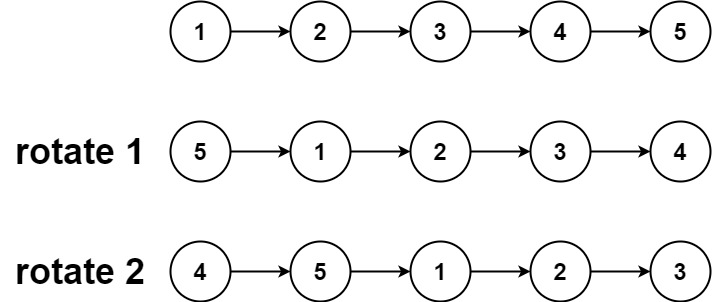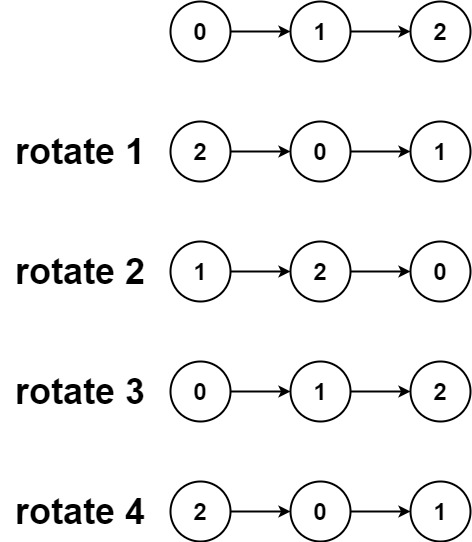📅Day-19 Striver’s SDE Sheet | Linked List and Arrays | Rotate a LinkedList, Clone a Linked List with random and next pointer.
 Payal Kumari
Payal Kumari
Note : Started my 27-day DSA journey with Striver’s SDE Sheet!
I will be journaling every day — recording what I learn, reflecting on it, and sharing it with my network to help fellow learners and aspiring developers.. Learning through videos, resources, and the internet — simplifying logic in my own way with real-world connections. Sharing 2 questions daily: brute-force to optimal, clean Java code, time & space complexity, and key patterns.
This blog series is for anyone preparing for coding interviews whether you’re a beginner or a revision warrior. Let’s grow together!
Namaste Developers! 🙏
Welcome to Day 19 of my 27-day DSA journey using Striver’s SDE Sheet!
1️⃣ Rotate List
🔸 Problem Statement:
Given the head of a linked list, rotate the list to the right by k places.
Example 1:

Input: head = [1,2,3,4,5], k = 2
Output: [4,5,1,2,3]
Example 2:

Input: head = [0,1,2], k = 4
Output: [2,0,1]
Constraints:
The number of nodes in the list is in the range
[0, 500].-100 <= Node.val <= 1000 <= k <= 2 * 10<sup>9</sup>
💠Real Life Example
Imagine you have a music playlist:[Song1, Song2, Song3, Song4, Song5]
Now your friend says – "Bro, play the last 2 songs first and then the rest."
So after rotation by k=2:[Song4, Song5, Song1, Song2, Song3]
\=> Boom! That’s exactly what Rotate Linked List is doing.
(Hinglish : Soch lo tumhare paas ek music playlist hai:
[Song1, Song2, Song3, Song4, Song5]
Ab tumhara dost bolta hai –
"Bro, pehle last ke 2 gaane chala, fir baaki."
Toh rotation k=2 ke baad playlist aisi ho jaati hai:
[Song4, Song5, Song1, Song2, Song3]
\=> Samjhe? Yehi kaam Rotate Linked List karta hai.)
1️⃣ Brute Force Approach
Idea: Rotate list one by one, k times.
Steps:
For each rotation:
Traverse till last node.
Make last node as new head.
Adjust links accordingly.
Repeat this process k times.
class Solution {
public ListNode rotateRight(ListNode head, int k) {
if (head == null || head.next == null || k == 0) return head;
int n = 0;
ListNode temp = head;
while (temp != null) {
n++;
temp = temp.next;
}
k = k % n;
if (k == 0) return head;
for (int i = 0; i < k; i++) {
ListNode prev = null, curr = head;
while (curr.next != null) {
prev = curr;
curr = curr.next;
}
prev.next = null;
curr.next = head;
head = curr;
}
return head;
}
}
📍Complexity
Time Complexity (TC) →
O(k * n)
(Because for each ofkrotations we traverse list of sizen)Space Complexity (SC) →
O(1)
(Only pointers used, no extra space)
2️⃣ Optimal Approach
Idea: Instead of rotating one by one, we use math & linked list properties.
Steps:
Find length
nof list.Connect last node → head (circular list).
Find effective rotations:
k = k % n.Break the list at
(n - k)position.New head will be
(n - k + 1)th node.
class Solution {
public ListNode rotateRight(ListNode head, int k) {
if (head == null || head.next == null || k == 0) return head;
// Step 1: Find length
ListNode temp = head;
int n = 1;
while (temp.next != null) {
n++;
temp = temp.next;
}
// Step 2: Make it circular
temp.next = head;
// Step 3: Effective rotations
k = k % n;
int stepsToNewHead = n - k;
// Step 4: Find new head
ListNode newTail = head;
for (int i = 1; i < stepsToNewHead; i++) {
newTail = newTail.next;
}
ListNode newHead = newTail.next;
newTail.next = null;
return newHead;
}
}
📍Complexity
Time Complexity (TC) →
O(n)
(One pass for length, one pass for finding new head)Space Complexity (SC) →
O(1)
(No extra space, only pointers)
2️⃣ Copy List with Random Pointer
🔸 Problem Statement:
A linked list of length n is given such that each node contains an additional random pointer, which could point to any node in the list, or null.
Construct a deep copy of the list. The deep copy should consist of exactly n brand new nodes, where each new node has its value set to the value of its corresponding original node. Both the next and random pointer of the new nodes should point to new nodes in the copied list such that the pointers in the original list and copied list represent the same list state. None of the pointers in the new list should point to nodes in the original list.
For example, if there are two nodes X and Y in the original list, where X.random --> Y, then for the corresponding two nodes x and y in the copied list, x.random --> y.
Return the head of the copied linked list.
The linked list is represented in the input/output as a list of n nodes. Each node is represented as a pair of [val, random_index] where:
val: an integer representingNode.valrandom_index: the index of the node (range from0ton-1) that therandompointer points to, ornullif it does not point to any node.
Your code will only be given the head of the original linked list.
Example 1:

Input: head = [[7,null],[13,0],[11,4],[10,2],[1,0]]
Output: [[7,null],[13,0],[11,4],[10,2],[1,0]]
Example 2:

Input: head = [[1,1],[2,1]]
Output: [[1,1],[2,1]]
Example 3:

Input: head = [[3,null],[3,0],[3,null]]
Output: [[3,null],[3,0],[3,null]]
Constraints:
0 <= n <= 1000-10<sup>4</sup> <= Node.val <= 10<sup>4</sup>Node.randomisnullor is pointing to some node in the linked list.
💠 Real World Terms
Imagine you’re making a guest list for a wedding.
Each guest has:
Name (val) → like "Rahul", "Priya", "John".
Next pointer → the person sitting next to them in the list.
Random pointer → a special link to their “plus one” friend/relative. (Could be anyone from the list, or no one).
Now, you want to copy the guest list completely into a new list for backup.
But here’s the catch The new guest list should not refer to the old one at all.
Rahul’s copy should point to Priya’s copy (not old Priya).
If Rahul’s random points to John, then Rahul-copy’s random should also point to John-copy.
This is exactly the Copy List with Random Pointer problem.
(Hinglish : Socho tum shaadi ke liye ek guest list bana rahe ho.
Har guest ke paas hai:
Name (val) → jaise "Rahul", "Priya", "John".
Next pointer → jo uske baad wali seat pe baitha hai list mein.
Random pointer → ek special link uske “plus one” dost/relative ko. (Ye koi bhi ho sakta hai list se, ya phir koi na ho).
Ab tumhe poori guest list copy karke ek nayi list banani hai backup ke liye.
Lekin catch ye hai ki nayi guest list purani wali ko refer nahi karegi.
Agar Rahul-copy hai to uska next Priya-copy hona chahiye (na ki old Priya).
Aur agar Rahul ka random John pe point kar raha hai, to Rahul-copy ka random bhi John-copy pe hi point kare.
\=> Yehi exactly Copy List with Random Pointer problem hai.)
Example → Original list:
Rahul → Priya → John
Rahul.random → John
Priya.random → Rahul
John.random → null
When you make a deep copy:
Rahul' → Priya' → John'
Rahul'.random → John'
Priya'.random → Rahul'
John'.random → null
Now, even if the old list is destroyed, the new one works independently.
1️⃣ Brute Force Approach
🔹 Steps
Traverse original list → create new nodes and store mapping
{oldNode → newNode}in a HashMap.Traverse again → for each old node,
newNode.next= map.get(oldNode.next)newNode.random = map.get(oldNode.random)
class Solution {
public Node copyRandomList(Node head) {
if (head == null) return null;
// Step 1: Store mapping old → new
HashMap<Node, Node> map = new HashMap<>();
Node temp = head;
while (temp != null) {
map.put(temp, new Node(temp.val));
temp = temp.next;
}
// Step 2: Connect next & random using map
temp = head;
while (temp != null) {
Node clone = map.get(temp);
clone.next = map.get(temp.next);
clone.random = map.get(temp.random);
temp = temp.next;
}
return map.get(head);
}
}
💠Complexity
Time Complexity (TC):
O(n)(2 traversals of list)Space Complexity (SC):
O(n)(HashMap storage for mapping)
2️⃣ Optimal Approach
🔹 Steps
Interweave nodes: For each node, insert its clone just after it.
Example:A → B → CbecomesA → A' → B → B' → C → C'Fix random pointers: If
A.random = B, thenA'.random = B'.Separate lists: Detach clone nodes to form the new list.
class Solution {
public Node copyRandomList(Node head) {
if (head == null) return null;
// Step 1: Insert clone nodes
Node temp = head;
while (temp != null) {
Node clone = new Node(temp.val);
clone.next = temp.next;
temp.next = clone;
temp = clone.next;
}
// Step 2: Set random pointers
temp = head;
while (temp != null) {
if (temp.random != null) {
temp.next.random = temp.random.next;
}
temp = temp.next.next;
}
// Step 3: Separate both lists
Node dummy = new Node(0);
Node copy = dummy;
temp = head;
while (temp != null) {
copy.next = temp.next;
copy = copy.next;
temp.next = temp.next.next;
temp = temp.next;
}
return dummy.next;
}
}
💠Complexity
Time Complexity (TC):
O(n)(3 traversals)Space Complexity (SC):
O(1)(No extra DS, only new nodes)
✍️ Final Notes:
If you're just starting your DSA journey like me, don't worry if you don’t get it perfect the first time.
Visualize → Dry Run → Optimize.
Stay consistent, and let’s crack every problem from brute to optimal! 💪
🙏 Special Thanks
A heartfelt thank you to Rajvikraaditya Sir for creating and sharing such an incredible DSA resource with the community (takeuforward). Your structured approach has made DSA more accessible and less intimidating for thousands of learners like me.
If this helped you, do share it with your fellow DSA learners.
Comment with your doubts — I’d love to answer and grow together 🌱
✍️ Payal Kumari 👩💻
My 27-Day DSA Journey with Striver’s Sheet! #dsawithpayal

Subscribe to my newsletter
Read articles from Payal Kumari directly inside your inbox. Subscribe to the newsletter, and don't miss out.
Written by

Payal Kumari
Payal Kumari
I'm a passionate full-stack developer with a strong foundation in the MERN stack—building and maintaining scalable web applications using React.js, Node.js, and Next.js. My journey in open source began with Hacktoberfest 2023, where I made four impactful pull requests that sparked a love for collaborative coding, global learning, and open knowledge sharing. Since then, I’ve contributed to and mentored projects in top open source programs like GSSoC’24, SSOC’24, and C4GT’24. As a Google Gen AI Exchange Hackathon ’24 Finalist and Google’s Women Techmakers (WTM) Ambassador, I’ve been privileged to support diverse communities in building meaningful tech solutions. My work as a Top 50 Mentor for GSSoC ’24 reflects my commitment to nurturing new talent in tech. Beyond development, I serve as a Student Career Guide, Profile Building Expert & Evangelist at Topmate.io, where I conduct workshops, guide students through resume building and career strategy, and help mentees navigate open source and tech careers. Recognized among the Top 5% of mentors and featured on “Topmate Discover,” I take pride in making mentorship accessible and impactful. My technical voice has also been acknowledged by LinkedIn, where I’ve earned the Top Voice badge seven times in domains like web development, programming, and software engineering. In addition, I hold LinkedIn Golden Badges for Research Skills, Interpersonal Skills, Critical Thinking, and Teamwork—signaling a well-rounded approach to both individual contribution and team collaboration. Graduating with an MCA from Chandigarh University in 2023, I’ve continued to fuel my curiosity by writing technical articles and sharing practical MERN stack insights across platforms. Whether it’s building polished UIs, optimizing backend performance, or guiding a mentee through their first pull request, I’m driven by the power of community and continuous learning. Let’s connect! I'm open to collaborations, mentorship, or building something impactful together. Reach out to me at kumaripayal7488@gmail.com or visit my profile on Topmate.io.